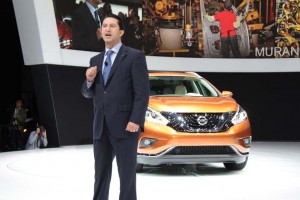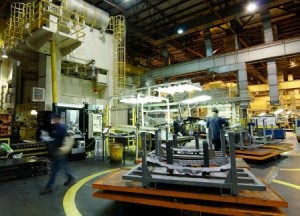For its part, Nissan operates two major assembly plants in the U.S. The biggest is in Smyrna, Tennessee, a plant capable of producing up to 650,000 vehicles annually, and employing 8,000 hourly workers. The mile long factory produces the midsize Altima and the Leaf battery-electric vehicle, among other models.
About 400 miles to the southwest, Nissan’s plant in Canton, Mississippi employs another 6,000 blue-collar workers. While production is lower than at Smyrna, the Canton factory is one of the most flexible in the American market, capable of production eight different models, including both car-like unibody vehicles, such as the Murano, and frame-based trucks.
As the first of Nissan’s new third-generation Murano crossovers roll into showrooms this month, buyers will find a lighter, more stylish and more fuel-efficient vehicle. But what only a few are likely to notice is that the new model also will be made in the U.S.
Nissan’s big assembly plant in Canton, Mississippi has become the new, global production base for the 2015 Murano – which until now had rolled off a Nissan line in Kyushu, Japan.
“We want to localize more of everything we do,” noted Pierre Loing, the head of product planning for Nissan North America.
The addition of the Murano means that roughly 85% of the vehicles Nissan expects to sell in the U.S. in 2015 will be produced in North America, primarily at the maker’s two Southern assembly plants – though some products, such as the updated Nissan Versa, will come from the company’s three factories in Mexico. That’s up from just 70% at the beginning of the decade.
Nissan isn’t alone in localizing production to North America. “Nearly 70% of what Toyota sells here is built in North America,” noted the Japanese giant’s spokesman Rick Bourgoise.
And Honda tops the charts, supplying nearly 95% of the vehicles sold in the U.S. from a network of factories in the U.S., Canada and Mexico. In fact, it “produces more automobiles in the U.S. than any other country,” spokesman Steve Kinkade told TheDetroitBureau.com, adding that it has invested $3.5 billion in its North American production operations during just the last three years.
(US motorists intrigued by autonomous cars – but wary about owning one. Click Here for the story.)
There are a variety of reasons why the top three Japanese makers have expanded their North American operations. For one thing, it reduces costs and increases flexibility to shift production of core vehicles, such as the Murano. The vast majority of that model are sold in the U.S., so building Murano in Canton not only reduces shipping costs but reduces the potential logistical and quality issues that can come with a supply chain leading back to Japan.
Nissan, like its competitors, also was motivated to act, according to industry watchers, in the wake of the big earthquake and tidal wave that struck Japanese in April 2011, all but shutting down the country’s auto industry for months.
Meanwhile, key production decisions were made earlier in the decade when the value of the yen rose to historic highs, “when it was not profitable to assemble vehicles in Japan,” explained David Sullivan, a senior automotive analyst with AutoPacific, Inc.
(Nissan launches teaser blitz for next-generation Titan pickup. Click Here to check it out.)
It will launch an all-new version of the full-size Nissan Titan pickup next year. That truck is scheduled to make its debut at the North American International Auto Show in January.
The bulk of the products Nissan sells in the U.S. are produced at those two plants, but the Juke crossover and subcompact Versa roll into the country from Mexico. A little more than a year ago, Nissan opened its third major assembly plant “South of the border,” a new complex in the central city of Aguascalientes.
Mexico’s automotive production base “is on fire,” said AutoPacific analyst Sullivan, pointing out that virtually every major global auto manufacturer is now either operating, or setting up, production in Mexico. The country not only has a low cost base but is in an ideal location to supply both North and South America. And it has negotiated more free trade agreements than any other country except Israel, further enhancing its role as an export base.
Between Mexico, Canada and the U.S., industry analysts expect to see even more production shift to the region in the years ahead.
(Click Here to find out why automakers are worried about the sudden plunge in fuel prices.)



The quote below should read, “…so building the Murano in Canton not only reduces shipping costs…” The Murano is not build in Smyrna. Thanks!
“The vast majority of that model are sold in the U.S., so building Murano in Smyrna not only reduces shipping costs but reduces the potential logistical and quality issues that can come with a supply chain leading back to Japan.”
“built” not “build” Ooops!
Thanks for the catches…